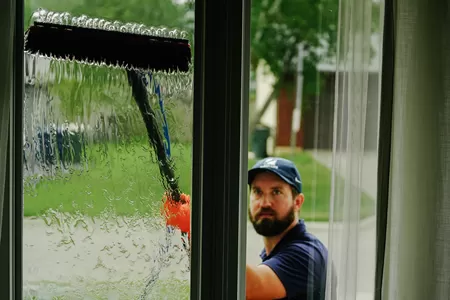Opening the Power of Pressure Laundering: A Thorough Check Out Reliable Exterior Cleaning Solutions for Decks, Fences, and Walkways
Stress cleaning stands out as a necessary device in outside upkeep, properly renewing decks, fences, and walkways by removing built-up dirt, mold, and crud. As we discover the complexities of stress cleaning, it ends up being obvious that the best approach can make a substantial difference-- yet many homeowners forget essential facets that might boost their cleaning efforts.
Advantages of Pressure Washing
Stress washing effectively renews surface areas, making it a crucial upkeep method for both property and commercial homes. One of the key benefits of pressure washing is its capacity to improve curb allure. By eliminating dust, mold and mildew, mildew, and gunk, pressure cleaning restores the initial look of surfaces, adding to a more welcoming environment. This is specifically crucial for companies aiming to bring in customers and for home owners wanting to keep building value.
Additionally, stress cleaning extends the life expectancy of surface areas. Routine cleansing can protect against the buildup of unsafe substances that result in degeneration, saving homeowner considerable expenses out of commission or substitutes. Pressure washing promotes health and security by getting rid of slippery substances, such as algae or moss, which can pose risks.
Another advantage is the efficiency of the process. Stress cleaning can cover huge locations in a portion of the moment it would take utilizing conventional cleansing approaches. This effectiveness is especially helpful for commercial buildings that call for minimal interruption to operations.
Getting Ready For Pressure Washing
Before taking part in pressure washing, mindful prep work is crucial to make sure ideal outcomes and shield bordering locations. Begin by assessing the location to be cleaned, removing any barriers such as furnishings, planters, or decorative items. This develops a clear work area and reduces the risk of damages during the cleaning process.
Next, examine the surfaces for any kind of loose paint, mold and mildew, or debris. Dealing with these issues in advance can improve the performance of the pressure cleaning. As an example, scraping off loosened paint can prevent it from being pushed into the surface throughout washing.
Furthermore, it is essential to shield close-by plants, home windows, and delicate surface areas. Consider covering plants with tarps or plastic bed linen and using painter's tape to protect windows from water damage (Roof Cleaning). Ensure that the stress washer is outfitted with the suitable nozzle and stress setups for the particular surface areas to prevent creating damage
Finally, prepare the stress washing machine by inspecting fluid levels and making certain all connections are safe. This prep work prepares for a successful pressure cleaning session, generating a tidy and revitalized exterior.
Techniques for Different Surfaces
Achieving ideal cleanliness needs a customized method to various surfaces during pressure cleaning. Each material, whether timber, concrete, or vinyl, requires specific methods to make sure effective cleansing without causing damage.
For wooden decks, utilizing a low-pressure setting is vital. This method protects against splintering and preserves the timber's stability. Employing a cleansing solution made for wood can enhance the elimination of gunk and mold, making certain an extensive tidy.
Concrete surfaces, on the various other hand, can stand up to greater stress levels. A follower nozzle is advised for large areas, while a slim nozzle can target tough spots effectively. Pre-treating stains with a degreaser can generate boosted outcomes, especially for oil or grease marks.
Plastic fencings need a gentler touch, similar to wood. A medium-pressure setup incorporated with a soft-bristle brush add-on can efficiently remove dust without scraping the surface. It is important to use a cleansing solution especially created for vinyl to avoid staining.
Choosing the Right Tools
Choosing the proper tools is necessary for successful stress cleaning, as it directly influences performance and cleaning outcomes. The first factor to consider is the pressure washing machine itself, which comes in numerous kinds: electrical, gas, and diesel. Electric versions are suitable for light-duty tasks such as cleansing decks and fences, while gas-powered makers pop over to this site provide higher pressure and are fit for tougher tasks like getting rid of grime from sidewalks.
Next, take into consideration the stress ranking measured in indoor power washer PSI (pounds per square inch) For delicate surface areas, a lower PSI (1,500 - 2,000) suffices, while extra robust products might call for scores of 3,000 PSI or even more. Furthermore, the flow price, gauged in GPM (gallons per min), is critical; greater GPM implies quicker cleansing.
Nozzles play a substantial duty in achieving wanted outcomes, with various shades indicating differing spray angles and stress. By carefully picking tools tailored to particular cleaning tasks, you can optimize performance and attain optimum results in your stress cleaning endeavors.

Upkeep Tips After Cleaning
Proper upkeep after stress washing is vital for extending the life expectancy of both the cleaned surfaces and the devices utilized. After finishing your pressure cleaning task, enable the surfaces to dry totally to stop wetness retention, which can cause mold and mildew and mold growth. For wood surfaces like decks and fencings, use a high-grade sealer or discolor to improve defense versus the aspects. This not only maintains the aesthetic appeal but likewise strengthens the wood against deteriorating and contorting.
Regularly roof treatment evaluate the cleaned areas for indicators of dust buildup or degeneration. Setting up regular cleansings based on ecological direct exposure can help preserve their appearance and integrity. For devices maintenance, guarantee that you completely cleanse the pressure washer after use, getting rid of any debris from the nozzle and pipes. In addition, inspect the oil levels and change filters as required to ensure optimal performance.
Store your pressure washing equipment in a dry, sheltered area to stop corrosion and damages. Roof Cleaning. Complying with these maintenance suggestions will not only keep your outdoor spaces looking pristine but also take full advantage of the effectiveness and life expectancy of your pressure washing equipment
Conclusion
